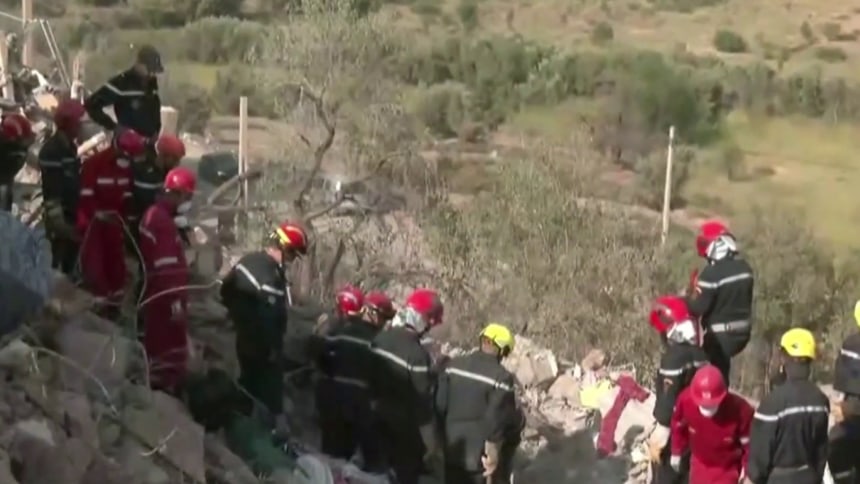High Impact Earthquake Devastation, Morocco
"When all of that collapses, you don't have much chance of surviving, because there are no air pockets [contrasted to areas where buildings are constructed of concrete or other strong materials].""People are generally suffocated by the dust [created when mud brick homes with wood roofs collapse in an earthquake].""Our role is not to find bodies."Arnaud Fraisse, founder, French aid group, Rescuers Without Borders"I was asleep when the earthquake struck. I could not escape because the roof fell on me. I was trapped. I was saved by my neighbours, who cleared the rubble with their bare hands.""Now, I am living with them in their house because mine was completely destroyed."Fatna Bechar, Tafeghaghte, Morocco
 |
| People inspect the damage caused by the earthquake in the village of Tafeghaghte, 62 kilometres south of Marrakech, Morocco, on Monday. (Mosa'ab Elshamy/The Associated Press) |
The strongest earthquake in the North African country of Morocco in over a century struck on Friday, leaving over 2,900 people dead and an equal number injured. Quake-prone areas of the country have homes most often constructed of mud bricks, stone and clay, with roofs of wood, leaving the hope of finding any survivors dim. Yet survivors of the quake, equipped with shovels dug alongside bulldozers on Monday, in remote Moroccan villages in a desperate bid to rescue those still alive, trapped in the rubble.
But as the days pass, hope dwindles that people will be found alive under their wood-and-dirt homes left pancaked into rubble. Overseas rescue groups still await permission from Morocco to allow them to travel to the country to help in the search. A French aid group specializing in locating victims trapped under debris withdrew its offer to send a search-and-rescue team after waiting for a green light from Moroccan authorities that failed to materialize.
To the present, officials in Morocco have accepted aid offered by governments in four countries; Spain, Qatar, Britain and the United Arab Emirates. Officials visualize avoiding a lack of co-ordination, explains Morocco's Interior Ministry, that "would be counter-productive".
According to an estimate by the United Nations, 300,000 people were affected by Friday night's magnitude 6.8 quake, which struck dangerously at a relatively shallow depth. Most of the deaths and the destruction occurred in Al Haouz province, located in the High Atlas Mountains, where houses folded with the quake's impact and steep, winding mountain roads became clogged with rubble. Local residents attempted to clear rocks away on their own initiative.
In the settlement of Tafeghaghte, remote and impoverished, villagers estimated that over half of the 160 inhabitants were killed. And although people saw the necessity to work quickly to clear dead bodies, a foul stench from dead cattle filled the atmosphere in a village which saw most of its buildings completely disintegrated.
The village, commented Ibrahim Ahdouch who lost two young daughters and two additional family members , resembled a war zone. "There's not shooting, but look around", he said. Survivors kept a distance from half-ruined buildings threatening to collapse. People cheered the day before when trucks carrying soldiers arrived in Amizmiz down the mountainside from Tafeghaghte, pleading for more help.
"It's a catastrophe.""We don't know what the future is. The aid remains insufficient."Survivor Salah Ancheu, Amizmiz villager
Army units were deployed along a paved road leading from Amizmiz to more remote mountain villages, with state news agency MAP reporting bulldozers and allied equipment are being used to clear routes. In some villages people wept as boys and helmeted police conveyed the dead through the streets. Tourists and residents lined up to give blood.
 |
| Rescue workers unearth a body recovered from under the rubble in the aftermath of a deadly earthquake in Talat N'Yaaqoub, in Morocco September 12, 2023. REUTERS/Hannah McKay |
Despite offers of help pouring in from around the globe, Moroccan authorities frustrated some overseas rescuers who awaited official approval before deploying, but that approval was not forthcoming. About 100 teams with roughly 3,000 rescuers in total registered with the United Nations could have deployed quickly to the city of Marrakech, also hit by the quake, according to Fraisse of Rescuers Without Borders.
Moroccan authorities, he surmised, could be recalling the logistical chaos that occurred when a 2004 quake killed over 600 people, and aid flights overwhelmed an airport located in the disaster zone. Morocco is "the master of its choices, which must be respected", observed French Foreign Minister Catherine Colonna, announcing the release of $5.4 million in emergency funds for Moroccan and international non-governmental groups rushing to help survivors.
In the ancient city of Marrakech, those left homeless, or fearing more aftershocks have slept out in the streets or under makeshift canopies in devastated Atlas Mountain towns. Aftershocks have since hit the zone, upsetting nerves among the locals in areas where damage has left buildings in entirely unstable conditions.
 |
| Moroccan
villagers race to dig for survivors in the rubble from Friday's
earthquake as the time limit for people to survive shrinks. The
earthquake that struck Morocco has killed at least 2,800 people. CBC |
Labels: Devastated Remote Villages, High Death Rate, High-Impact Earthquake, Morocco, Rescue Missions
0 Comments:
Post a Comment
<< Home